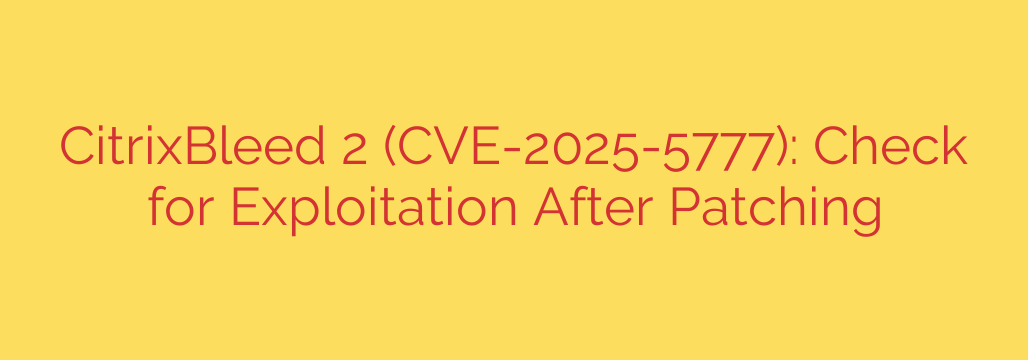
Urgent Security Alert: Checking for Exploitation After Patching CitrixBleed 2 (CVE-2025-5777)
In the evolving landscape of cybersecurity threats, staying vigilant is paramount. A new serious security vulnerability, identified as CitrixBleed 2 (CVE-2025-5777), is impacting Citrix environments, specifically certain versions of Citrix Gateway and ADC appliances. This vulnerability poses a significant risk, potentially allowing unauthorized access and impacting the confidentiality and integrity of your systems.
While vendor patches are being released and applying them immediately is absolutely critical, the nature of this particular vulnerability requires an additional, crucial step. Security experts are emphasizing that simply patching vulnerable systems might not be enough to fully mitigate the risk.
The Challenge: Exploitation Before Patching
The primary concern with CitrixBleed 2 is the possibility of exploitation occurring before the security patch is applied. If attackers successfully leveraged this vulnerability prior to patching, they might have already gained a foothold within your network or stolen sensitive information, such as session tokens that grant unauthorized access.
Why Post-Patch Verification is Essential
Even with the vulnerability itself closed by the patch, pre-existing compromise means attackers could potentially retain access through backdoors they established or stolen credentials/session data they acquired. Therefore, organizations must actively check for signs of exploitation after applying the patch. Treating the patch as the final step is a dangerous oversight.
What to Look For: Indicators of Compromise (IoCs)
Security teams should conduct a thorough investigation post-patch deployment to identify any signs of malicious activity. Key areas to examine include:
- Unusual Account Activity: Look for newly created user accounts, unexpected changes to existing accounts, or logins from unfamiliar locations or at unusual times.
- Suspicious Network Connections: Monitor outgoing traffic for connections to known malicious IP addresses or unexpected data exfiltration.
- Modified System Configurations: Check for unauthorized changes to system files, registry keys, or scheduled tasks.
- Unexpected Running Processes: Identify any unfamiliar processes running on the vulnerable appliances or connected systems.
- Log Anomalies: Review logs from the Citrix devices and associated security infrastructure for errors, warnings, or events that correlate with potential exploitation attempts or successes.
Recommended Actions:
- Prioritize Patching: Immediately apply the official security patches for CVE-2025-5777 provided by the vendor.
- Conduct Forensic Analysis: After patching, perform a detailed review of logs and system states for the period before the patch was applied.
- Hunt for IoCs: Actively search for the indicators of compromise mentioned above.
- Assume Compromise Until Proven Otherwise: If there’s any suspicion of pre-patch exploitation, initiate your incident response plan.
- Rotate Credentials: Consider rotating credentials for users and systems that accessed resources through the potentially compromised appliances.
- Strengthen Monitoring: Enhance ongoing security monitoring for your Citrix environment and connected systems.
Addressing the CitrixBleed 2 (CVE-2025-5777) vulnerability requires a two-pronged approach: rapid patching and diligent post-patch verification for signs of compromise. Taking these steps is vital to ensuring the security and integrity of your critical infrastructure.
Source: https://www.helpnetsecurity.com/2025/07/08/cve-2025-5777-indicators-of-compromise/








